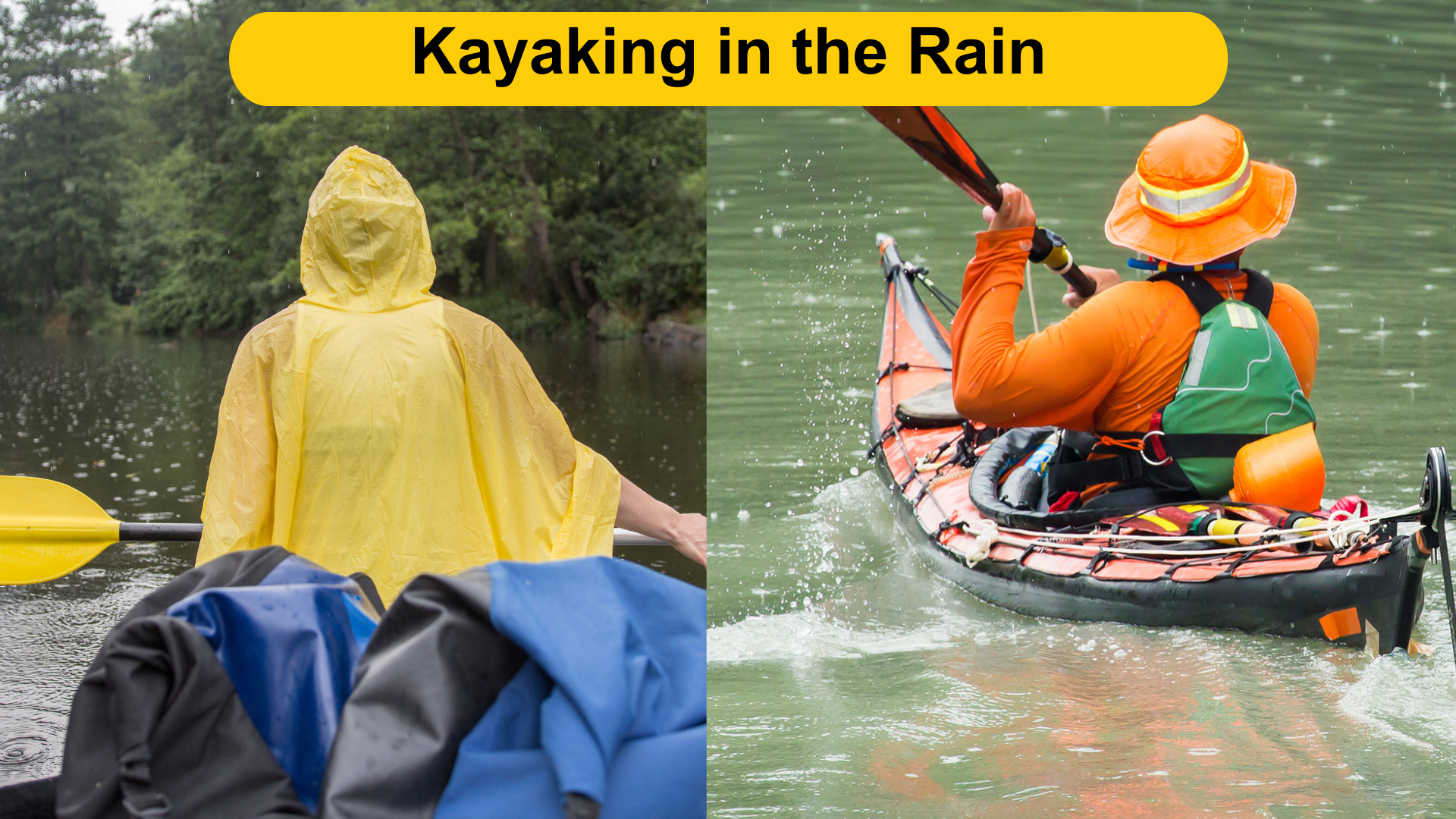Kayaking in the Rain | A Guide to Safe Paddling
Set against a backdrop of endless gray clouds, the gentle lapping of waves in the lake can be heard as a light mist of rain trickles down. The morning sun glinting off the raindrops creates a shimmering sensation in the air as the coolness of the water beckons kayakers to jump in.
The thrill of kayaking in the rain is unlike any other. With the droplets of rain cascading over the kayak, the view of the horizon is distorted, yet the feeling of paddling through the water is at its most peaceful and serene. The sound of the raindrops against the craft creates a calming melody, and the misty lake is the perfect place to explore, leaving the kayaker feeling invigorated and alive.
What to Wear Kayaking in The Rain
To ensure maximum comfort and protection from the rain, a waterproof jacket, rain pants, and waterproof shoes are essential items. The jacket should fit snugly and keep the wearer dry, while the rain pants should be lightweight and provide breathability. The waterproof shoes should provide a secure grip and keep the feet dry in wet conditions.
Waterproof Jacket

When selecting a waterproof jacket for kayaking, you’ll want to pay attention to the material. Look for a jacket made with waterproof fabric such as Gore-Tex or another waterproof, breathable membrane. These special fabrics will keep you dry while also allowing your body to breathe. Additionally, try to choose a jacket with a full-length zipper and a drawstring hood for extra protection from the rain.
Finally, look for a waterproof jacket with reflective details such as piping or logos. This will help you stay safe and visible when kayaking in low-light conditions. With the right waterproof jacket, you’ll be prepared to brave the rain and enjoy your kayaking experience.
Rain Pants
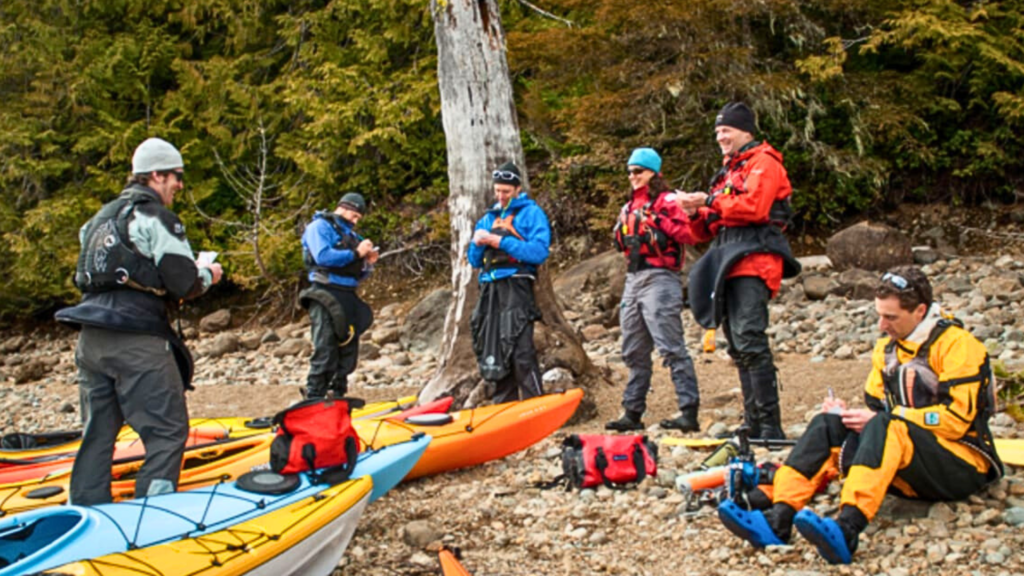
To stay dry and comfortable in even the wettest of conditions, rain pants are an essential item of apparel for any kayaker. Constructed from highly durable waterproof material, rain pants are designed to protect against wind and water while allowing for breathability for a comfortable fit.
Featuring taped seams and an adjustable waistband, rain pants create a snug fit to keep the elements at bay while providing unrestricted movement for paddling. The outer layer of rain pants is usually made from a nylon or polyester blend, and the inner layer is often lined with a breathable material such as microfleece or mesh.
For the ultimate protection from the elements, rain pants can be paired with a waterproof jacket and a pair of waterproof shoes for a complete outfit that will keep the kayaker dry and comfortable in any condition.
Waterproof Shoes

Moving on to another essential piece of apparel when kayaking: waterproof shoes It is essential to wear a pair of shoes that can protect your feet from moisture and prevent them from slipping. Waterproof shoes are designed to keep water from getting in while also providing adequate protection from the elements.
They are often made of materials like neoprene or rubber, which are both incredibly durable and provide great traction in wet conditions. The soles of these shoes usually have a non-slip grip to prevent slipping and offer great stability on the kayak. Additionally, most waterproof shoes are designed to be lightweight and comfortable, allowing you to paddle for extended periods of time without discomfort.
Furthermore, some waterproof shoes come with an adjustable fit system that allows you to customize the fit and ensure that your feet stay dry and comfortable. With all these features, you can be confident that your feet will be well protected when kayaking.
Can You Kayak in a Thunderstorm?

The calm surface of the lake can quickly be changed by sudden weather changes, making it important to take safety precautions. With thunderstorms, lightning hazards can be particularly dangerous and must be taken into consideration. It is vital to pay close attention to weather conditions, as kayaking in a thunderstorm is simply not safe.
Safety Precautions
Thinking about kayaking in a thunderstorm may seem daunting, but if you take the right safety precautions, it can be both a thrilling and safe experience. Before embarking on a kayaking trip during a thunderstorm, it’s important to consider the safety precautions that must be taken.
The most important safety precaution when kayaking during a thunderstorm is to know when it’s safe to be on the water. Generally speaking, you should avoid kayaking during a thunderstorm if it’s accompanied by strong winds, hail, or lightning. If you’re unsure about the weather conditions, it’s best to err on the side of caution and stay off the water.
Additionally, it’s important to prepare for the storm by dressing appropriately. It’s essential to wear a life jacket and other protective gear, such as a waterproof jacket, pants, and boots. This will help keep you dry and warm even if you do get caught in the rain. Additionally, it’s important to bring along a reliable navigation system so you can stay on the right course even when visibility is low.
Overall, if you take the right safety precautions, kayaking in a thunderstorm can be a safe and thrilling experience. Just be sure to check the weather conditions before you go, wear the proper protective gear, and bring along a reliable navigation system.
Weather Conditions
If the storm is brewing in the distance, it may be safe to proceed, but if it is already overhead and you can hear thunder and lightning, it is best to stay on the shore. It is also important to pay attention to wind speed and direction. Wind can be a powerful force when it comes to kayaking, and if the wind is blowing in the same direction as the lightning, it may be a sign that you should head back to shore.
It is also important to understand the kind of thunderstorm you are dealing with. Is it a typical summer storm or a more serious storm with hail or high winds? If the storm is particularly severe, it is best to stay on shore and wait it out. Similarly, if the storm is accompanied by heavy rain, it is important to be aware of the potential for flash flooding. In such situations, it is best to stay on shore until the storm has passed.
By taking the time to analyze the weather conditions, you can make an informed decision on whether or not it is safe to kayak in a thunderstorm. With the right preparation and caution, it can be a thrilling and safe experience.
Lightning Hazards
Lightning is a common hazard in thunderstorms, and it can have devastating effects. This is especially true when out on the water since the electrically charged nature of the atmosphere causes lightning to be attracted to metal objects. To minimize the associated risks, it’s important to steer clear of any tall objects, including trees, metal poles, and even tall boats, as these can act as lightning rods.
Additionally, if you do happen to get caught in a thunderstorm, it’s important to stay as low as possible and huddle with your group as far away from any metal objects as possible. While it may be difficult to do while in the water, this will further reduce the risk of being struck by lightning.
Ultimately, kayaking in a thunderstorm should be avoided at all costs. Not only can the wind and rain present a challenge, but lightning can also be incredibly dangerous. By following the safety protocols outlined above, you can help ensure that you stay safe while out on the water.
Best Rain Gear for Kayaking
When kayaking, it is essential to be equipped with the right gear. A waterproof rain hat helps keep the rain from dripping, while a pair of rain gloves protect hands from the chill and dampness. To guard against the water, a spray skirt provides an extra line of defense to keep the kayak dry and comfortable.
Rain Hats
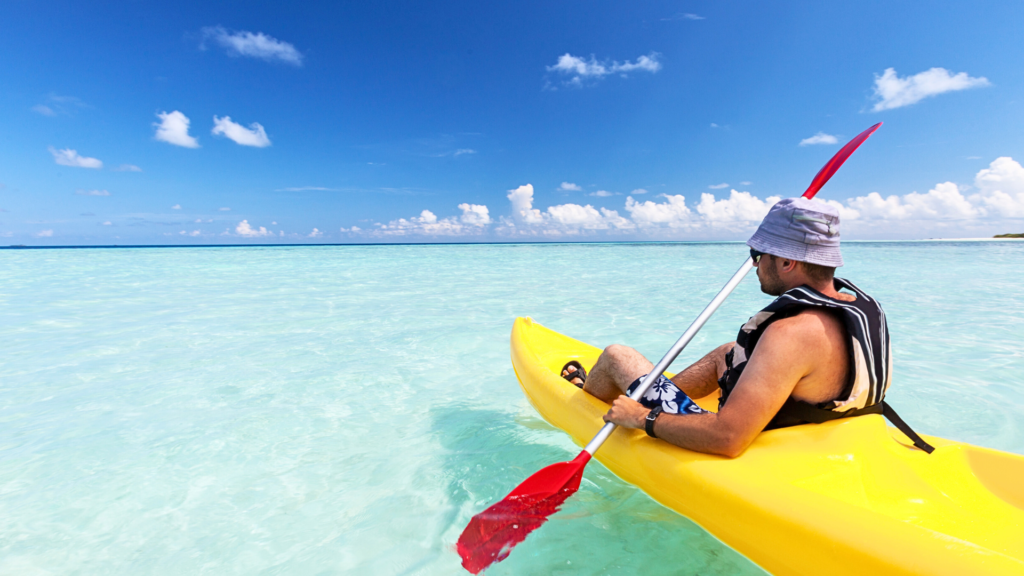
When shopping for a rain hat, try to find one made from durable materials like lightweight nylon or polyester. These materials are lightweight and waterproof, and they can withstand the elements without tearing or fading.
Look for a hat with a wide brim, so it covers your neck and face, and make sure it is adjustable if you plan to wear it in different conditions. A rain hat with a drawstring or chin strap will help keep it in place during windy conditions.
Rain Gloves
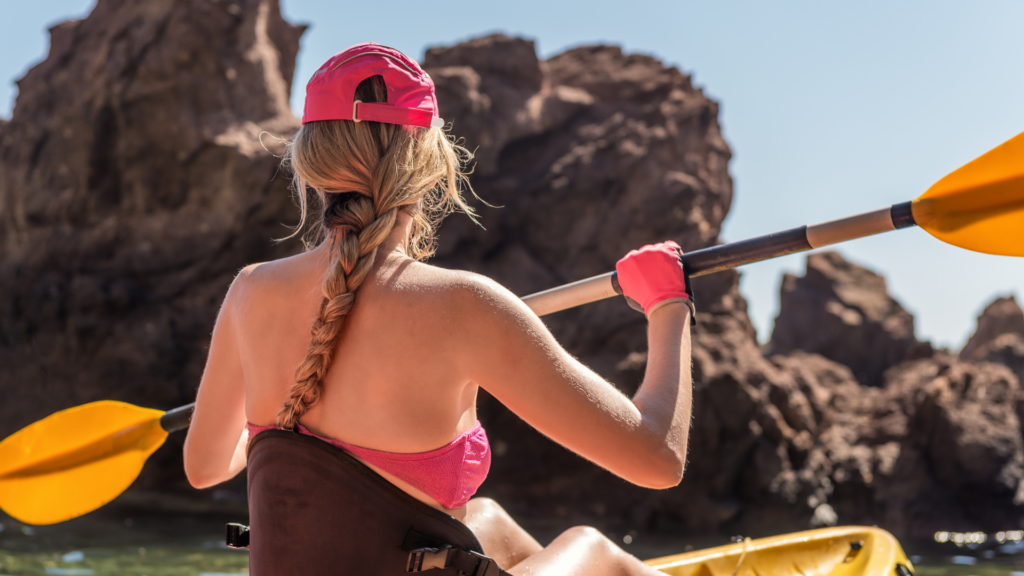
Rain gloves offer unparalleled grip and dexterity when kayaking in wet and unpredictable conditions. Not only do they help prevent a slip of the paddle, but they also provide warmth and protection against the elements. For kayakers, a pair of waterproof gloves is a game-changer.
The best rain gloves for kayaking should be designed with a waterproof outer shell and a breathable inner lining, allowing them to withstand the toughest of storms while keeping hands dry and comfortable. Look for gloves designed specifically for kayaking, with reinforced gripping zones and adjustable straps to create a secure fit.
To ensure optimal performance, choose a pair that is lightweight and flexible, allowing for unrestricted movement and a strong grip on the paddle.
Waterproof Spray Skirt
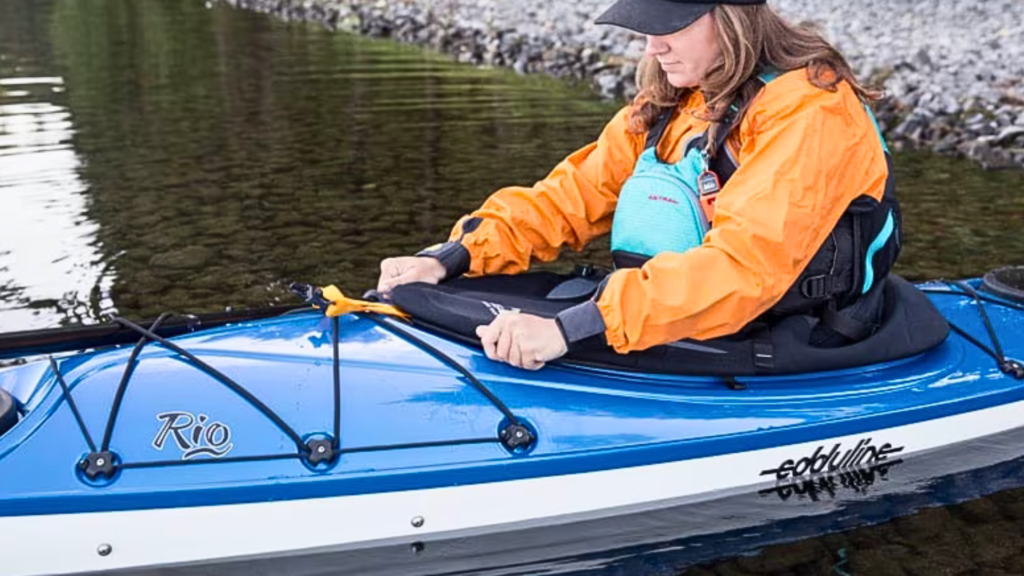
This essential piece of equipment is designed to fit snugly around the rim of the kayak, creating a seal that keeps the water from entering the kayak. The skirt is usually constructed from waterproof or water-resistant material and is often reinforced with an elastic drawstring around the waist for a secure fit.
Additionally, many spray skirts are designed with a splash guard in the front and back to further protect the kayaker from getting wet. While there are some generic spray skirts available, it’s important to get a skirt specifically designed for your kayak.
Different kayaks have different shapes and sizes, and it’s important to get a spray skirt that fits your kayak perfectly for the best water-tight seal. Doing so will ensure that you stay dry and comfortable while out on the water, no matter the weather.
Tips for Kayak in the Rain
Navigating in the rain can be tricky, especially for inexperienced kayakers. Safety should always be your top priority, so determine the safest course before setting out on the water. Staying warm and dry is essential; dress in layers and wear protective gear to keep out the rain. Lastly, waterlogged equipment can be a hassle, so make sure to bring spare items or waterproof your gear.
Navigation and Safety
When the visibility is low, it’s important to be aware of your surroundings and stay close to shore. Make sure to always stay in visual contact with your group and to communicate your plans and location with each other.
If you plan on taking a longer trip, it’s important to alert the authorities of your plans in case you need assistance. Additionally, be aware of any changing weather conditions and be prepared to turn back and seek shelter if needed.
Finally, it’s important to stay alert and attentive while kayaking on a rainy day. Listen and look for signs of other boats and any changes in the weather. Be prepared to adjust your plans if needed, and always have a plan for getting back to shore in case of an emergency.
Staying Warm and Dry
When kayaking during rain, staying warm and dry can be a challenge. To stay comfortable and safe, it’s important to have the right equipment and knowledge. Wearing a good waterproof rain jacket is essential, preferably one that is breathable and has a hood to keep water off the face. Layering is key, as is wearing a balaclava or a warm hat under the hood.
A good pair of waterproof pants will help keep the lower body warm and dry, and if needed, wearing a pair of lightweight waterproof gaiters will keep the shoes and ankles dry. Additionally, having a dry bag on board is a great way to keep important items such as a change of clothes, food, and a first aid kit safe from the elements.
Dealing with Waterlogged Equipment
With the right gear, kayaking on a rainy day can be an invigorating and enjoyable activity. But what happens when equipment gets wet? Successfully dealing with waterlogged equipment is vital to having a safe and comfortable kayaking experience.
It is important to ensure that all equipment is waterproof and has been properly sealed with a sealant. Dry bags are an ideal way to keep items dry and secure. If items do get wet, they must be dried out as soon as possible.
This can be done by using a dry towel to absorb most of the moisture and then allowing the items to air dry in a warm, dry area. If any electrical items have gotten wet, they must be taken apart and dried very carefully to avoid any short-circuiting.
How Dangerous Is Kayaking During Rain?
When the rain starts to fall, kayakers should consider their safety. Protective clothing and paddling techniques are essential when it comes to braving the rain.
A kayaker must prepare for the effects of the rain on their kayaking experience, from wet clothes to dangerous conditions. With the right equipment, knowledge, and techniques, a rainy-day kayaking trip can be a thrilling and safe adventure.
Effects of Rain on Kayaking Safety
Mentally bracing themselves for the rain, kayakers should also consider the potential effects on their safety. Rain changes the nature of the water, creating higher waves, more difficult currents, and less visibility.
The decreased visibility can be especially dangerous when venturing into unfamiliar waters, as landmarks and obstacles that may be normally visible become hidden, making navigation difficult.
Additionally, more turbulent waters can increase the likelihood of capsizing, particularly for inexperienced kayakers. To mitigate this risk, it is important to take safety precautions.
Clothing for Rainy Day Kayaking
Having discussed some tips for rainy-day kayaking, let’s now focus on what clothing you should wear. When kayaking, it is important to dress appropriately to stay warm and dry. The most important piece of clothing is a waterproof jacket. Look for one that is designed for kayaking and is made from a breathable material.
It should also have a hood and a pocket for keeping smaller items like your phone or keys dry. In addition to the jacket, you should also wear a pair of waterproof pants. Again, look for ones designed specifically for kayaking that are breathable and have zippered pockets. A waterproof beanie is also a great way to keep your head dry in the rain.
If you are paddling for a long period of time, you may want to wear a lightweight raincoat with a hood to keep your back and arms dry. Finally, make sure to bring some extra layers of clothing.
These can include a fleece jacket and a pair of wool socks. These can be worn over the waterproof layers to keep you warm and dry, no matter how cold or wet the day may be. All of these items will help you stay safe and comfortable while kayaking during rain.
Paddling Techniques for Rainy Kayaking
While kayaking during rain can be a thrilling experience, it is important to have the right paddling technique if you want to stay safe. To help ensure the safety of kayakers in wet conditions, here are a few paddling techniques to consider.
First and foremost, it is important to always keep the kayak as straight as possible. While the rain can make it more difficult to stay on course due to the waves and winds, it is essential to maintain the same direction with each stroke. To achieve this, kayakers should use long and steady strokes, as this will be more efficient and provide better control in the water.
It is also important to adjust the intensity of each stroke depending on the weather conditions; if it is windy, stronger strokes may be necessary to keep the boat on track.
In addition, kayakers should take advantage of eddies when paddling in the rain. Eddies are areas of water that flow in the opposite direction of the main current, and they can provide a good respite from the main flow. As such, kayakers can take the opportunity to rest and gather their bearings in eddies before continuing on their journey.
Finally, it is important to remember to use a slight lean when paddling in the rain. This will help keep the boat balanced and prevent it from tipping over in rough conditions. With these techniques in mind, kayakers can stay safe and enjoy their rainy-day adventure.
Conclusion
Kayaking in the rain can be an exciting and rewarding experience. However, it’s important to take the necessary precautions to ensure your safety and comfort.
Be sure to wear the right gear, check the weather conditions, and follow the tips for kayaking. With the right preparation and knowledge, you can enjoy the beauty of the outdoors, even when the rain is pouring down.

